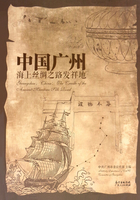
Ⅲ. The Window of Cultural Exchanges between China and the World
British philosopher, Bertrand Russell, once observed that the contact of different civilizations has often become the landmark of the progress of mankind. In the history of the development of the Maritime Silk Road, the contact and exchange among different civilizations also became a recurring pattern. It was such exchanges that projected such splendid vitality into the diverse civilizations of different regions. As the origin of the Maritime Silk Road and the gateway and path for China's link with the world, Guangzhou has played a central role in connecting China and the world, making a major contribution to the global progress of civilization.
Foreign merchant ships left Guangzhou laden with Chinese traditional products popular in the world then such as silk, porcelains and tea, via the Maritime Silk Road, to different parts of the world. Along with these products, they also carried with the Chinese artistic and cultural styles reflected in their designs, mode of production, fashions and interior and landscape design. In the 18th century, for example, the exported paintings, porcelain, silverware, and fans with Chinese elements and Lingnan styles were introduced into the West and became the vogue of the Western society, forming a social trend of "Chinese taste" in Western society. The introduction of culture as such not only impacted the ways of living in the countries or regions along the Maritime Silk Road, but also enhanced their spiritual and cultural life. The Maritime Silk Road also spread the farming techniques of growing mulberry trees and harvesting silkworms, weaving silk, and porcelain-making technologies, as well as traditional Chinese medicine and treatment. These, in turn, enhanced the development of silk weaving and porcelain industries, and made significant contributions to the socio-economic and cultural development of diverse societies around the world.
Conversely, the Maritime Silk Road also brought China foreign produce such as pearl, germ, rhinoceros horns, ivories, spices, minerals such as alluvial gold, silver, brass, animals and plants, and cash crops and new species such as cotton, longans, tomatoes, corn, sweet potatoes, sunflowers, and potatoes from all over the world,together with advanced sciences and technologies, and new cultural perspectives in philosophy, medicine, astronomy, biology, geology, law, aesthetics, literature and art.
Similarly, with the opening of the Maritime Silk Road, Chinese Confucianism and Taoism were introduced to the West; while Buddhism, Islam and Christianity were introduced to China. Guangzhou proved to be a major center of the transmission of these civilizations. The introduction of Buddhism into China during the Eastern Han dynasty found in the Maritime Silk Road one of its richest outreach channels. Dharma--the eminent Indian monk, it is believed by some, came to China from the sea route in the Southern dynasty, landing in Guangzhou and set up Xilai (coming from the West) Temple and started his preaching of Buddhism. Dharma is recognized globally as the founder of several sects of Chinese Buddhism, Chan, with an essential knowledge of Buddhism. Some believe that the Buddha came to Guangzhou where a temple was named First Footprint of Xilai. Buddhists also went afar from Guangzhou to India for the profound Buddhist scriptures and teachings. In 671, the 2nd year of Xianheng, Yijing, a prominent monk, went from Guangzhou, via the maritime route, through Sumatra to India, passing over 30 countries. When he came back from India, Yi Jing brought with him about 400 Buddhist scriptures, as well as one set of the original diamond-seat (vajrasana), and 300 Buddhist relics (Sarira), which became treasures of Chinese Buddhism.
The introduction of Islam to China, firstly in the Tang dynasty, was closely related with the Maritime Silk Road and Guangzhou. Guangzhou at that time served as a center of foreign trade, also a gathering place for Arabs, especially the Persians. The legend recorded that Mohamed, the founder of Islam, had four disciples, named the "Four Sages", who came to China during the middle of the reign of Emperor Wude of the Tang dynasty. The First Sage preached in Guangzhou, the Second Sage in Yangzhou, the Third and the Fourth in Quanzhou. In 628, the 2nd year of Zhenguan, Prophet Mohamed sent Sadibn Abi Waqqas to preach in Guangzhou, who traveled to Quanzhou, Hangzhou and Changan, and then returned to Guangzhou and was buried here after his death. Guangzhou has kept the relics of the Muslim Sage Tomb with great care. The Huaisheng Light Tower Temple was built for the Arabs to conduct meditations during the Tang dynasty. These relics witnessed the history of the introduction of Islam into Guangzhou.
As to Christianity, the Nestorians was introduced into China as early as the Tang dynasty. During the middle of the 16th century, one of the founders of Jesuits of Catholics, Francisco Javier came to Guangdong to preach. At the end of the Ming dynasty, Guangzhou became the critical path of the transmission of Catholics into China. In 1807, Robert Morrison, a missionary from the Protestant Church in London came to Guangzhou to preach Protestantism. Apart from religion, the Western missionaries brought with them the early modern Western science and technology, and culture knowledge. Guangzhou thus became a bridge for the introduction of the Western knowledge to the East. In the 19th century, the first Chinese-English dictionary, the first English newspaper and Western hospital in China all came into being in Guangzhou. The convergence of multiple cultures and the spread of religions made Guangzhou a center of Lingnan Culture that absorbs new winds from the Four Seas, and a center of diversification, openness, tolerance and innovation.